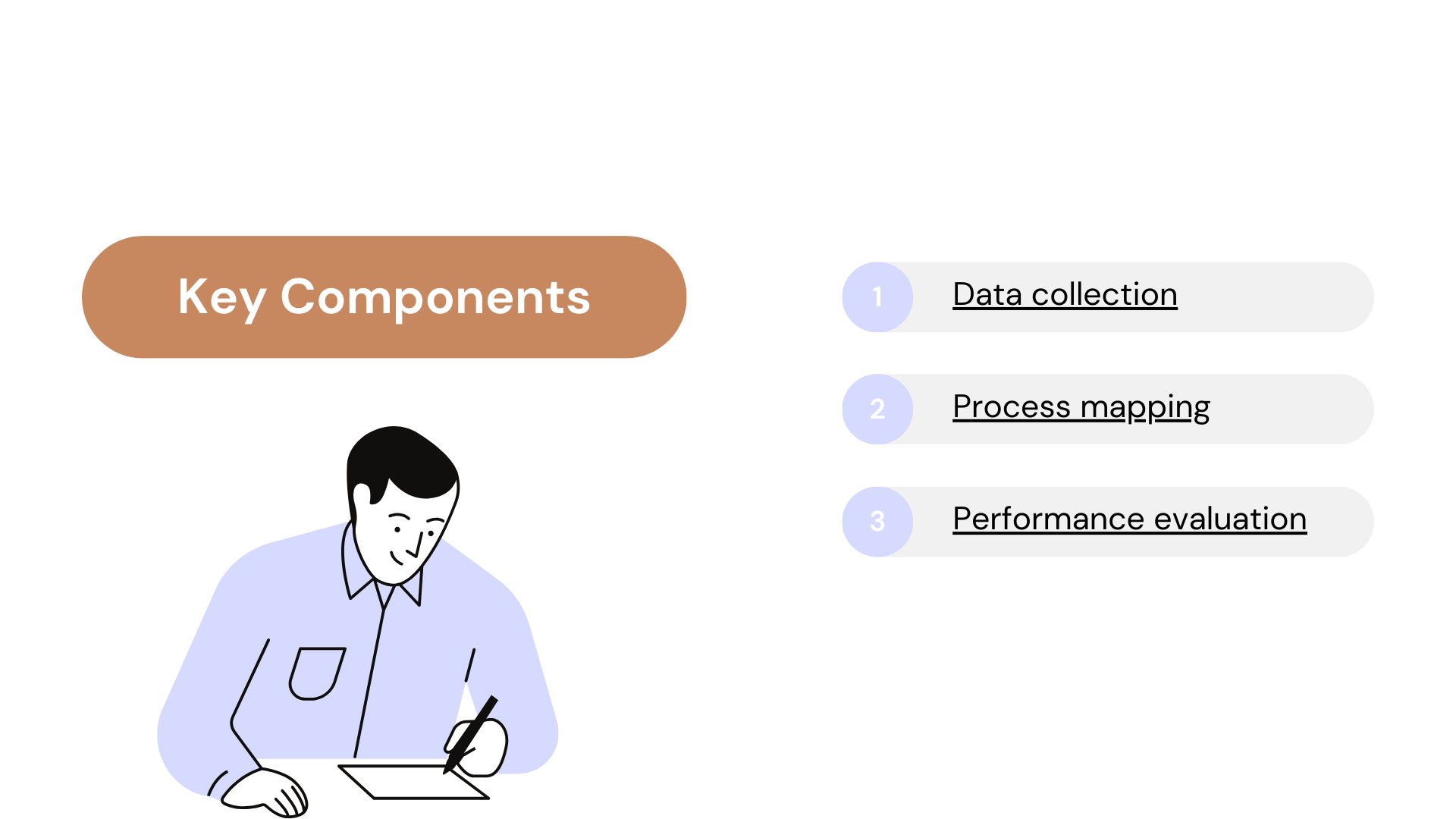Table of Contents:
- What Is Workflow Analysis? Definition and Overview
- The Importance and Benefits of Workflow Analysis
- Types of Workflow Analysis
- Workflow Analysis Methods
- Steps to Conduct Workflow Analysis
Introduction
Have you ever felt like your workday is an endless cycle of reacting and responding, leaving you frazzled and unproductive? You're not alone.
The truth is, that most people have no idea how much wasted time and energy is built into their daily workflow.
The good news is, there's a simple solution: workflow analysis. By taking a systematic look at how you work, you can identify opportunities to trim the fat, reduce redundancies, and optimize your time for maximum impact.
In this blog, we'll dive deep into everything there is to know about workflow analysis. From the basic definition to the steps involved, the importance and benefits, the types, and methods to analyze existing workflow, we'll be shedding light on every detail.
What Is Workflow Analysis? Definition and Overview
So what exactly is workflow analysis? Simply put, it's the process of evaluating how work actually gets done in your organization.
Workflow analysis involves the detailed breakdown of a work process to identify bottlenecks, inefficiencies, and possibilities for improvement.
The goal is to identify any inefficiencies or bottlenecks that are preventing optimal productivity and make improvements.
When you analyze your workflow, you're taking a deep dive into how tasks and information move between people and departments. You look at things like:
- The specific steps required to complete a process
- How much time each step takes
- Where communication breaks down
- Any redundancy or duplication of effort
The Importance and Benefits of Workflow Analysis
Every business, regardless of its size, seeks to streamline its operations in order to improve productivity and efficiency.
One potent way businesses can achieve these goals is through Workflow Analysis.
But what exactly does a workflow analysis entail, and why is it vital?

The importance of workflow analysis includes:
Identify Inefficiencies and Bottlenecks
A comprehensive workflow analysis can help identify the points within the process that are causing delays or inefficiencies.
Bottlenecks can arise due to communication gaps, resource restrictions, or poorly coordinated tasks.
By identifying these points, measures can be taken effectively to address them.
Enhance Alignment and Communication
With an accurate workflow analysis, all stakeholders involved will have a clear understanding of their roles and responsibilities.
It ensures everyone is on the same page regarding the tasks they need to undertake, the sequence of those tasks, and the outcomes expected.
This alignment fosters effective communication and paves the way for smoother operations.
Facilitate Training
Training new employees or switching job positions within a company can be made much more efficient with a clear workflow to refer to.
It acts as an invaluable resource for training and onboarding, with every step of the process clearly mapped out, leaving no room for confusion.
Regulatory Compliance
Some industries need to comply with specific regulations for their operations.
A well-documented workflow analysis can provide proof of adherence to these regulations and make the audit process more straightforward.

Workflow analysis is key to boosting efficiency and productivity in any organization.
It helps you identify bottlenecks and inefficiencies that are slowing you down.
Maybe you'll discover that a critical task is taking three times longer than it should due to outdated technology or redundant approvals.
Or perhaps you'll find that a process involves far more steps than necessary, wasting time and resources.
Once you've pinpointed the issues, you can set about streamlining your workflow.
Benefits of workflow analysis include:
Increased efficiency & productivity
One of the premier benefits of workflow analysis is that it can significantly bolster efficiency.
By examining the steps involved in a work process and analyzing each one, businesses can identify bottlenecks and inefficiencies.
Reducing or eliminating these inefficiencies can lead to smoother operations, faster turnarounds, and improved overall productivity.
Improved quality & accuracy
Simplifying processes and ensuring the right tasks are performed by properly skilled individuals leads to higher-quality work with fewer errors or defects.
By outlining workflows and analyzing processes, employees get a clear understanding of their roles and responsibilities, which reduces errors and maximizes accuracy.
Reduced costs
A more efficient process equates to more savings in terms of both time and monetary resources.
Trimming waste and optimizing workflow saves money through lower operational and labor expenses.
Streamlining also minimizes the risk of costly mistakes.
Higher job satisfaction
Simpler, more logical procedures and less repetition or redundancy make work more interesting and meaningful for your team.
Morale and motivation improve as a result.
Better collaboration
Workflow analysis maps out each process in detail, outlining who is responsible for what, and when each step needs to be completed.
Analyzing how people, tasks, and information connect helps identify communication breakdowns and ensures stronger links between interdependent roles or departments.
This not only improves internal communication but also ensures that everyone is aware of their responsibilities, which leads to more aligned and synchronized operations.
Better Decision Making
With workflow analysis, decision-making becomes more data-driven and informed.
Leaders get a clear view of the entire process, can identify performance issues, evaluate options, and make strategic decisions that align with business objectives and improve operational performance.
Greater Customer Satisfaction
Improved efficiency, better quality control, and quicker turnarounds directly impact customer satisfaction.
When you deliver better products faster, customers are more likely to be satisfied with your service, leading to increased customer retention and loyalty.
Types of Workflow Analysis

Workflow analysis is a vital activity, aimed at identifying bottlenecks, removing redundancies, and smoothening processes to enhance efficiency within a business.
There are several types of workflow analysis, focusing on different aspects of a process:
- Functional Workflow Analysis: This type of analysis concentrates on the functional aspects of a process. It identifies the sequence of tasks, interdependencies among the tasks, and potential bottlenecks. In simple words, it unravels how a task moves from start to finish within a workflow.
- Resource Workflow Analysis: Here, the focus is on the effective utilization of resources such as manpower, capital, time, raw materials, and more. It helps in determining if the proper resources are being effectively utilized or if there's wastage that can be avoided.
- Organizational Workflow Analysis: This analysis looks at the roles and responsibilities in the workflows and checks for any misalignment. It evaluates if individuals are performing the right tasks and if there are overlaps or gaps in roles.
- Technical Workflow Analysis: This type of analysis assesses how well technology is incorporated into the workflow. It checks if specific software tools or systems are optimally integrated and if they are a help or hindrance to the process.
- Process-Specific Workflow Analysis: Sometimes, an organization may need to focus on a specific process such as customer service, sales, or supply chain. This specialized workflow analysis delves deeper into that particular area to rectify issues or optimize the process.
- Value Chain Workflow Analysis: This type of analysis looks at the bigger picture, assessing how each workflow contributes to the overall value chain. It identifies any inefficiencies in the workflows that might be impacting the value generation.
Remember, successful workflow analysis relies heavily on your understanding of the current process, clear identification of inefficiencies, and the strategic implementation of improvements.
Workflow Analysis Methods
There are several useful methods for analyzing your workflow. Each provides a different perspective to help you identify inefficiencies and opportunities for improvement.
Process mapping
Process mapping involves visually documenting the steps in a workflow. You can create a high-level map to see the overall flow or a detailed map showing each task.
Process maps help you identify bottlenecks, redundancies, and unnecessary steps. They provide an easy way to communicate the workflow to others.
Time studies
Time studies evaluate how long each task in a workflow takes. This helps determine if there are any constraints on time or resources that are limiting productivity.
You can then make adjustments to balance workloads and ensure deadlines are reasonable. Time studies also point out any unnecessary or overly long steps.
Interviews
Interviewing employees who are directly involved in a workflow provides valuable insight into their experiences and perspectives.
Interviews can uncover pain points, frustrations, workarounds, and suggestions for improvement that you may miss with just process mapping or time studies alone.
Be sure to interview both managers and individual contributors for a complete picture.
Workflow simulation
Workflow simulation uses software to model the flow of a process and helps you analyze the impact of changes before implementing them.
You enter data on tasks, resources, and constraints to simulate the workflow. The software identifies key metrics like cycle time, resource utilization, and throughput to optimize.
Simulation is useful for complex workflows but requires specialized software and expertise to set up the model.
Ready to turbocharge your company's efficiency and streamline your work processes?
Steps to Conduct Workflow Analysis
Now that you understand the importance of workflow analysis, it’s time to dive into how to actually conduct one.

It involves three main steps: data collection, process mapping, and performance evaluation.
The basic steps are:
Prepare and Plan
First, determine the workflow or process you want to analyze. Then schedule time with the people involved in that workflow to observe, interview, and gather information.
Come prepared with a list of questions about the goals, inputs, outputs, and challenges of the current workflow.
Map the Existing Workflow
Next, map out the sequence of steps in the existing workflow from start to finish. Use visual mapping tools like flowcharts, diagrams, or pen and paper.
Talk to employees and observe them directly to see how things actually work. Look for bottlenecks, redundancies, and inefficiencies.
Identify what’s working well and what could be improved.
Analyze and Evaluate
Dig into the details of the workflow to evaluate how effective and efficient it is. Consider:
- Is the workflow achieving the desired goals and outcomes? If not, what’s missing?
- How much time is spent on value-added vs. non-value-added tasks? Look for ways to minimize waste.
- Are there any barriers or roadblocks slowing things down? How can they be removed?
- Do employees have the right tools, training, and resources they need? If not, make a list of potential solutions.
- How can the workflow be optimized and streamlined while still maintaining quality? Look for ways to simplify and improve.
Identify and Implement Improvements
Based on your analysis, make recommendations for improving the workflow. Meet with employees to review your suggestions and get their input and buy-in.
Then work together to implement approved changes, track their impact, and make any necessary tweaks.
Continually optimizing your workflows can significantly boost efficiency, productivity, and the bottom line.
Conclusion
So there you have it, the basics of workflow analysis. As you've learned, understanding your business processes and optimizing them can have huge benefits for productivity and efficiency.
Now that you know the steps, it's time to roll up your sleeves and get to work analyzing your own workflow.
Start with mapping your current processes, look for areas of waste or inefficiency, get input from your team, and make a plan to implement improvements.
It may take time, but the payoff in higher quality work and less frustration will make it worth the effort.
Workflow analysis isn't rocket science - it's really just common sense practices. Put these tips into action and watch your productivity soar!







